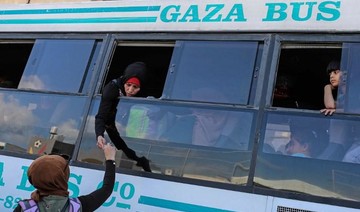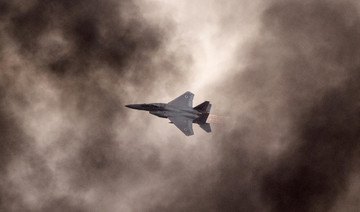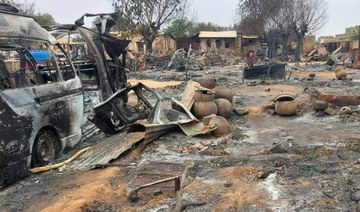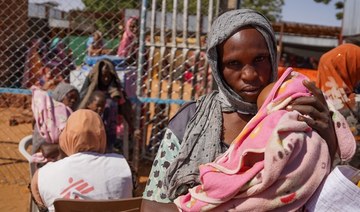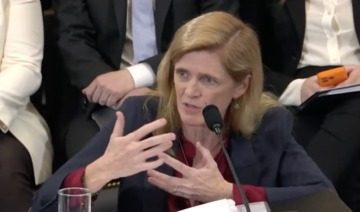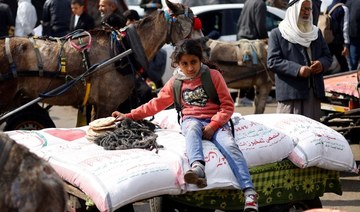GAZA CITY: Palestinians resumed their fiery protests at Gaza's border with Israel on Friday as a U.N. human rights body criticized Israel for the "disproportionate and indiscriminate use of force" that killed at least 59 Palestinians earlier this week.
Friday's Gaza protests — the eighth in as many weeks — drew Israeli gunfire and tear gas, with at least 23 people wounded, the Gaza Health Ministry said. Israel's military said they were transferred to Jordan for medical treatment.
The leader of Gaza's ruling movement Hamas attended the fresh protest held on the first Friday of the holy Muslim month of Ramadan, taking part in prayers along the border before sunset and then participating in a demonstration.
Ismail Haniyeh gave the V-for-victory salute and waved the Palestinian flag a few hundred metres (yards) from the fence along the border with Israel.
The Israeli army said around 1,000 "rioters" gathered in five spots along the border.
Speaking at a Gaza City mosque earlier on Friday, Haniyeh denied a deal had been made to end seven weeks of border protests, vowing they would continue.
"The marches will not stop until the siege is lifted completely from the Gaza Strip."
Egyptian President Abdel Fattah al-Sisi announced late Thursday at the start of Ramadan that his country's border with Gaza would be open throughout the holy month of fasting to "alleviate the suffering" of Gazans.
Palestinian media have speculated a deal has been struck for Egypt, which has a 1979 peace treaty with Israel, to open the border in exchange for Hamas ending the protests.
Haniyeh welcomed Sisi's decision but denied any such agreement.
"There is a rumour that Hamas made a deal with Egypt to end the marches. This is baseless," he said.
Organizers of the protests say they are meant in large part to break the blockade imposed by Israel and Egypt and to pressure Israel to ease its restrictions. Since the demonstrations began March 30, more than 110 Palestinians have been killed and more than 2,500 wounded by live fire, according to the Health Ministry. Palestinian officials say most of the casualties have been unarmed protesters. One Israeli soldier has been wounded.
The weekly protests peaked Monday when about 40,000 Gazans descended on the border. As in previous demonstrations, the protesters burned tires and hurled firebombs and stones toward Israeli troops, and tried to attack the border fence. Israeli snipers opened fire in response, killing 59 Palestinians and wounding hundreds in the deadliest day of cross-border violence in Gaza since a 2014 war between Israel and Hamas.
Friday's protests began later than in recent weeks and drew a smaller turnout, apparently due to the Ramadan fast. Most of participants gathered in tent camps a safe distance from the border, but dozens still got close to the fence.
In Geneva, the U.N. Human Rights Council voted to set up a commission of inquiry to look into the Israeli actions.
Meeting in a special session, the council voted 29-2 with 14 abstentions to back a resolution that also condemned "the disproportionate and indiscriminate use of force by the Israeli occupying forces against Palestinian civilians."
The "independent, international commission of inquiry" mandated by the council will be asked to produce a final report in March 2019.
U.N. High Commissioner for Human Rights Zeid Ra'ad al-Hussein backed calls for an international inquiry and questioned Israel's assertion that its security forces tried to minimize casualties.
"There is little evidence of any attempt to minimize casualties on Monday," he said.
Some demonstrators threw firebombs, used slingshots, flew burning kites into Israel to set fields ablaze and tried to use wire-cutters on the border fences, but "these actions alone do not appear to constitute the imminent threat to life or deadly injury which could justify the use of lethal force," said Zeid, a Jordanian prince.
Israeli Prime Minister Benjamin Netanyahu denounced the resolution, which was put forward by countries including Pakistan, as "nothing new under the sun."
"An organization that calls itself the Human Rights Council once again proves that it is hypocritical and biased and that its purpose is to harm Israel and support terror. But mostly it has proven that it is irrelevant," Netanyahu said.
"Israel completely rejects the resolution that was adopted by an automatic anti-Israel majority whose results were known from the start," he said. "Israel will continue to defend its citizens and soldiers as it has the right to defend itself."
Israeli ambassador Aviva Raz Schechter said "the unfortunate outcome of Monday's riots can only be attributed to Hamas' cynical exploitation of its own population in a violent campaign against Israel."
U.S. Ambassador to the United Nations Nikki Haley said in a statement that "the U.N.'s so-called Human Rights Council has decided to launch an investigation into a democratic country's legitimate defense of its own border against terrorist attacks. It is another shameful day for human rights."
In an apparent attempt to ease the crisis, Egyptian President Abdel-Fatah el-Sissi announced the opening of the Rafah crossing on Thursday night for what would be the longest uninterrupted period since 2013. He wrote on his official Twitter account that it would "alleviate the burdens of the brothers in the Gaza Strip."
Egypt and Israel have imposed a blockade on the Gaza Strip since 2007, heavily restricting movement in and out of the densely populated and impoverished territory.
Over the years, Egypt has opened the crossing for a few days every two to three months, the only way for most Gazans to reach the outside world.
Hamas leader Ismail Haniyeh said the opening was the result of talks Sunday in Cairo with Egyptian officials.
"We are witnessing the outcome through steps Egypt has taken, and we hope they continue, develop and increase," he said at a Friday prayer sermon in Gaza City. But he added that the weekly Hamas-led protests will continue.
The crossing has been open since May 12, so el-Sissi's announcement was technically an extension. Egyptian authorities said 510 people crossed Wednesday, with most going from Gaza to Egypt. On Thursday, 541 people passed into Gaza along with dozens of trucks carrying cement, steel, power engines and medical and food aid from the Red Crescent, the officials said.
Last month, Hamas' Interior Ministry said more than 20,000 people were on waiting lists to exit. An average of 500 travelers a day moved through the border this week, mostly leaving.
The Rafah crossing has only been open sporadically since the 2013 ouster of Egypt's Islamist President Mohammed Morsi, a high-ranking member of Hamas' parent group, The Muslim Brotherhood. While Egypt has been struggling with an Islamic insurgency for decades, militant attacks increased after Morsi's ouster, leading Egyptian authorities to tighten movement to and from Gaza.
Travel through Rafah has mostly been restricted to humanitarian cases, with priority given to medical patients, students admitted to outside universities and Palestinians with residency permits in third countries about to expire. Palestinian-Egyptians and dual nationals are also eligible to apply.
Travelers moved slowly toward the border Friday. A bus arrived about every hour with people whose names appeared on lists provided by Hamas officials.
Hamas forcibly wrested control of Gaza in 2007 after winning legislative elections, triggering the Israeli-Egyptian blockade that has severely restricted the movement of most of Gaza's 2 million inhabitants.
After more than a decade of Hamas rule, conditions for most inhabitants are dire. Unemployment is over 40 percent, tap water is undrinkable and Gazans receive only a few hours of electricity a day. Hospitals face constant shortages from the blockade, and parts of the territory are still waiting to be rebuilt after a 2014 war with Israel.
The measures were meant to create a buffer zone as part of Egypt's efforts to purge northeastern Sinai of Islamic militants following the 2014 bombings by an Islamic State group affiliate that killed dozens of soldiers.
Egypt imposed a state of emergency and curfew in northeastern Sinai, including Rafah, which means travelers arriving at the crossing after 7 p.m. must wait until the next morning to leave.
Gaza border protests resume as UN calls for inquiry
Gaza border protests resume as UN calls for inquiry

- Hundreds joined by Hamas leader Ismail Haniyeh at protest on Gaza-Israel border on the first Friday of the month of Ramadan
- Haniyeh said the marches will not stop until the siege is lifted completely from the Gaza Strip
UN official warns famine in northern Gaza is already ‘full-blown’
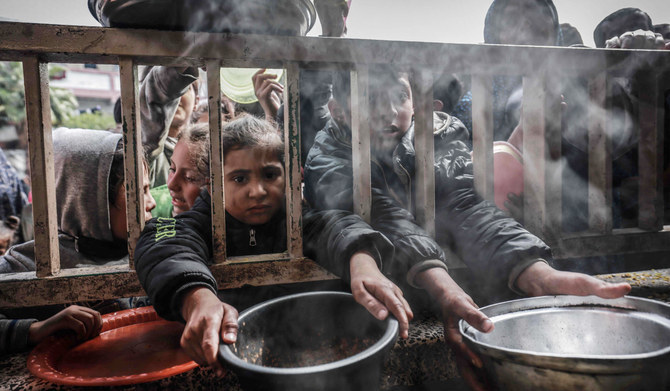
- Israel has killed more than 34,000 Palestinians since Oct. 7 attacks by Hamas
- There was no immediate comment from Israel, which controls entrance into Gaza
WASHINGTON: A top UN official said Friday that hard-hit northern Gaza was now in “full-blown famine” after more than six months of war between Israel and Hamas and severe Israeli restrictions on food deliveries to the Palestinian territory.
Cindy McCain, the American director of the UN World Food Program, became the most prominent international official so far to declare that trapped civilians in the most cut-off part of Gaza had gone over the brink into famine.
“It’s horror,” McCain told NBC’s “Meet the Press” in an interview to air Sunday. “There is famine — full-blown famine — in the north, and it’s moving its way south.”
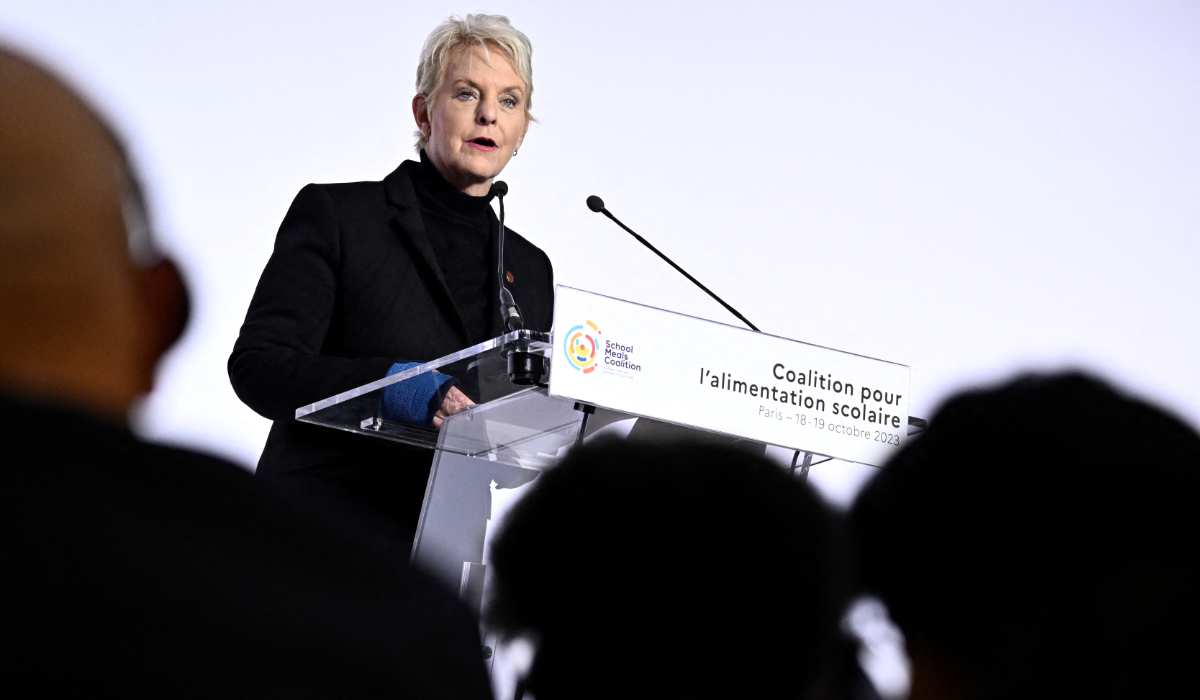
She said a ceasefire and a greatly increased flow of aid through land and sea routes was essential to confronting the growing humanitarian catastrophe in Gaza, home to 2.3 million people.
There was no immediate comment from Israel, which controls entrance into Gaza and says it is beginning to allow in more food and other humanitarian aid through land crossings.
The panel that serves as the internationally recognized monitor for food crises said earlier this year that northern Gaza was on the brink of famine and likely to experience it this month. The next update will not come before this summer.
One of the US Agency for International Development’s humanitarian officials in Gaza told The Associated Press that on-the-ground preparations for a new US-led sea route were on track to bring in more food — including treatment for hundreds of thousands of starving children — by early or mid-May. That’s when the American military expects to finish building a floating pier to receive the shipments.
Ramping up the delivery of aid on the planned US-backed sea route will be gradual as aid groups test the distribution and security arrangements for relief workers, the USAID official said.
The official spoke on condition of anonymity over security concerns for work done in a conflict zone. They were some of the agency’s first comments on the status of preparations for the Biden administration’s $320 million Gaza pier project, for which USAID is helping coordinate on-the-ground security and distribution.
At a factory in rural Georgia on Friday, USAID Administrator Samantha Power pointed to the food crises in Gaza and other parts of the world as she announced a $200 million investment aimed at increasing production of emergency nutritional paste for starving children under 5.
Power spoke to factory workers, peanut farmers and local dignitaries sitting among pallets of the paste at the Mana nonprofit in Fitzgerald. It is one of two factories in the US that produces the nutritional food, which is used in clinical settings and made from ground peanuts, powdered milk, sugar and oil, ready to eat in plastic pouches resembling large ketchup packets.
“This effort, this vision meets the moment,” Power said. “And it could not be more timely, more necessary or more important.”
Under pressure from the US and others, Israeli officials in recent weeks have begun slowly reopening some border crossings for relief shipments.
But aid coming through the sea route, once it’s operational, still will serve only a fraction — half a million people — of those who need help in Gaza. Aid organizations including USAID stress that getting more aid through border crossings is essential to staving off famine.
Children under 5 are among the first to die when wars, droughts or other disasters curtail food. Hospital officials in northern Gaza reported the first deaths from hunger in early March and said most of the dead were children.
Power said the UN has called for 400 metric tons of the nutritional paste “in light of the severe hunger that is pervading across Gaza right now, and the severe, acute humanitarian crisis.” USAID expects to provide a quarter of that, she said.
Globally, she said at the Georgia factory, the treatment made there “will save untold lives, millions of lives.”
USAID is coordinating with the World Food Program and other humanitarian partners and governments on security and distribution for the pier project, while US military forces finish building it. President Joe Biden, under pressure to do more to ease the humanitarian catastrophe in Gaza as the US provides military support for Israel, announced the project in early March.
US Central Command said in a statement Friday that offshore assembly of the floating pier has been temporarily paused due to high winds and sea swells, which caused unsafe conditions for soldiers. The partially built pier and the military vessels involved have gone to Israel’s Port of Ashdod, where the work will continue.
A US official said the high seas will delay the installation for several days, possibly until later next week. The official, who spoke on condition of anonymity to discuss operation details, said the pause could last longer if the bad weather continues because military personnel and divers have to get into the water for the final installation.
The struggles this week with the first aid delivery through a newly reopened land corridor into north Gaza underscored the uncertainty about security and the danger still facing relief workers. Israeli settlers blocked the convoy before it crossed Wednesday. Once inside Gaza, the convoy was commandeered by Hamas militants, before UN officials reclaimed it.
In Gaza, the nutritional treatment for starving children is most urgently needed in the northern part of the Palestinian territory. Civilians have been cut off from most aid supplies, bombarded by Israeli airstrikes and driven into hiding by fighting.
Acute malnutrition rates there among children under 5 have surged from 1 percent before the war to 30 percent five months later, the USAID official said. The official called it the fastest such climb in hunger in recent history, more than in grave conflicts and food shortages in Somalia or South Sudan.
One of the few medical facilities still operating in northern Gaza, Kamal Adwan hospital, is besieged by parents bringing in thousands of children with malnutrition for treatment, the official said. Aid officials believe many more starving children remain unseen and in need, with families unable to bring them through fighting and checkpoints for care.
Saving the gravely malnourished children in particular requires both greatly increased deliveries of aid and sustained calm in fighting, the official said, so that aid workers can set up treatment facilities around the territory and families can safely bring children in for the sustained treatment needed.
The UN warns Sudan’s warring parties that Darfur risks starvation and death if aid is not allowed in
The UN warns Sudan’s warring parties that Darfur risks starvation and death if aid is not allowed in
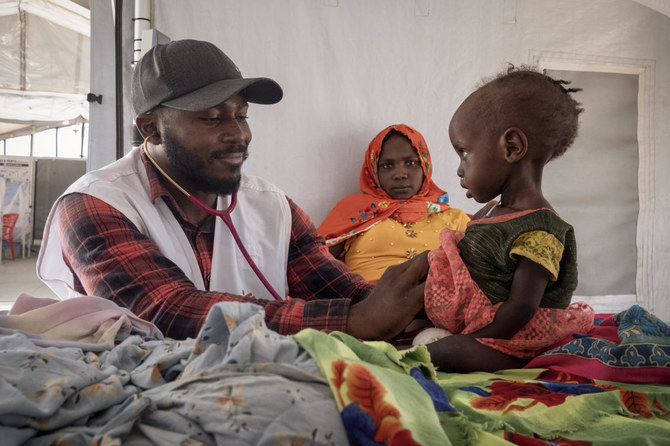
- At least 1.7 million people in Darfur were experiencing emergency levels of hunger in December
- Sudan plunged into chaos in mid-April 2023, when long-simmering tensions between the military and the paramilitary forces broke out into street battles
UNITED NATIONS: The United Nations food agency warned Sudan’s warring parties Friday that there is a serious risk of widespread starvation and death in Darfur and elsewhere in Sudan if they don’t allow humanitarian aid into the vast western region.
Leni Kinzli, the World Food Programme’s regional spokesperson, said at least 1.7 million people in Darfur were experiencing emergency levels of hunger in December, and the number “is expected to be much higher today.”
“Our calls for humanitarian access to conflict hotspots in Sudan have never been more critical,” she told a virtual UN press conference from Nairobi.
Sudan plunged into chaos in mid-April 2023, when long-simmering tensions between its military led by Gen. Abdel Fattah Burhan, and the paramilitary Rapid Support Forces commanded by Mohammed Hamdan Dagalo, broke out into street battles in the capital, Khartoum. Fighting has spread to other parts of the country, especially urban areas and the Darfur region.
The paramilitary forces, known as the RSF, have gained control of most of Darfur and are besieging El Fasher, the only capital in Darfur they don’t hold, where some 500,000 civilians had taken refuge.
Kinzli said WFP’s partners on the ground report that the situation in El Fasher is “extremely dire” and it’s difficult for civilians wanting to flee the reported RSF bombings and shelling to leave.
She said the violence in El Fasher and surrounding North Darfur is exacerbating the critical humanitarian needs in the entire Darfur region, where crop production for staple cereals like wheat, sorghum and millet is 78 percent less than the five-year average.
On top of the impact of escalating violence, Kinzli said, “WFP is concerned that hunger will increase dramatically as the lean season between harvests sets in and people run out of food.” She said a farmer in El Fasher recently told her that her family had already run out of food stocks and is living day-to-day, an indication that the “lean season,” which usually starts in May, started earlier.
Kinzli said she received photos earlier Friday from colleagues on the ground of severely malnourished children in a camp for displaced people in Central Darfur, as well as older people “who have nothing left but skin and bones.”
“Recent reports from our partners indicate that 20 children have died in recent weeks of malnutrition in that IDP camp,” she said.
“People are resorting to consuming grass and peanut shells,” Kinzli said. “And if assistance doesn’t reach them soon, we risk witnessing widespread starvation and death in Darfur and across other conflict-affected areas in Sudan.”
Kinzli called for “a concerted diplomatic effort by the international community to push the warring parties to provide access and safety guarantees” for humanitarian staff and convoys.
“One year of this devastating conflict in Sudan has created an unprecedented hunger catastrophe and threatens to ignite the world’s largest hunger crisis,” she warned. “With almost 28 million people facing food insecurity across Sudan, South Sudan and Chad, the conflict is spilling over and exacerbating the challenges that we’ve already been facing over the last year.”
In March, Sudanese authorities revoked WFP’s permission to deliver aid from neighboring Chad to West Darfur and Central Darfur from the town of Adre, saying that crossing had been used to transfer weapons to the RSF. Kinzli said restrictions from Sudanese authorities in Port Sudan are also preventing WFP from transporting aid via Adre.
Sudanese authorities approved the delivery of aid from the Chadian town of Tina to North Darfur, but Kinzli said WFP can no longer use that route for security reasons because it goes directly into besieged El Fasher.
On Thursday, gunmen in South Darfur killed two drivers for the International Committee of the Red Cross and injured three ICRC staff members. On Friday, UN humanitarian chief Martin Griffith called the killing of aid works “unconscionable.”
Kinzli said the fighting “and endless bureaucratic hurdles” have prevented WFP from delivering aid to over 700,000 people in Darfur ahead of the rainy season when many roads become impassable.
“WFP currently has 8,000 tons of food supplies ready to move in Chad, ready to transport, but is unable to do so because of these constraints,” she said.
“WFP urgently requires unrestricted access and security guarantees to deliver assistance,” she said. “And we must be able to use the Adre border crossing, and move assistance across front lines from Port Sudan in the east to Darfur so we can reach people in this desperate region.”
Hamas ‘only thing standing between the people of Gaza and a ceasefire’: Blinken
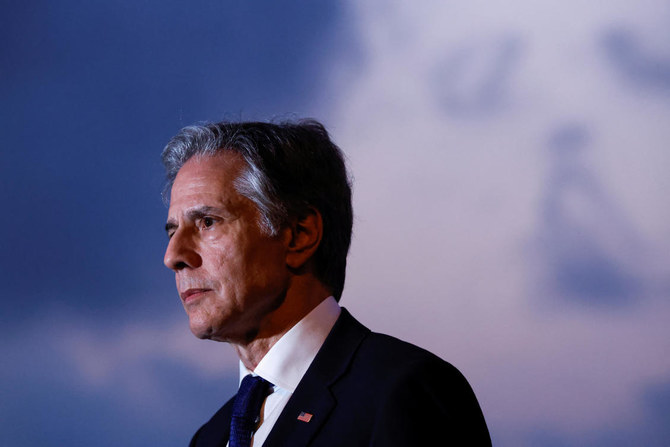
- ‘We wait to see whether, in effect, they can take yes for an answer on the ceasefire and release of hostages’
- But official says US cannot support a major military operation going into Rafah
“We wait to see whether, in effect, they can take yes for an answer on the ceasefire and release of hostages,” Blinken said late Friday.
“The reality in this moment is the only thing standing between the people of Gaza and a ceasefire is Hamas.”
Blinken pointed to difficulties in negotiating with Hamas, which the United States considers a terrorist group and does not engage with directly and which Israel has vowed to eliminate.
“The leaders of Hamas that we’re indirectly engaged with — through the Qataris, through the Egyptians — are, of course, living outside of Gaza,” Blinken said.
“The ultimate decision-makers are the folks who are actually in Gaza itself with whom none of us have direct contact.”
Blinken was addressing a dinner at the McCain Institute’s Sedona Forum in Arizona two days after meeting Israeli Prime Minister Benjamin Netanyahu and other top leaders on his latest visit to the Middle East.
Ahead of his talks with Blinken, Netanyahu vowed to push ahead with an assault on the southern Gaza city of Rafah to root out Hamas regardless of the outcome of negotiations for a temporary ceasefire that would involve the release of hostages.
President Joe Biden’s administration has repeatedly warned Netanyahu’s government against moving on Rafah, where some 1.4 million Palestinians have taken shelter after fleeing the Israeli assault in response to the October 7 attack by Hamas.
Blinken said that Israel, which counts on the United States for military and diplomatic support, has yet to present “a credible plan to genuinely protect the civilians who are in harm’s way” in Rafah.
“Absent such a plan, we can’t support a major military operation going into Rafah because the damage it would do is beyond what’s acceptable,” Blinken said.
France condemns attack on Red Cross in Sudan
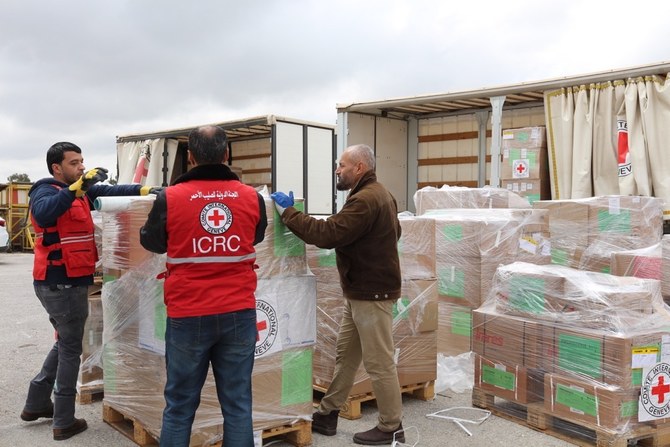
PARIS: France on Friday condemned “in the strongest terms” an attack on an International Committee of the Red Cross convoy in war-torn Sudan that killed two staff and injured three others.
“France calls on all parties to the conflict to respect their obligations under international humanitarian law, which obliges them to protect humanitarian and health staff and guarantee complete, safe and unhindered humanitarian access,” said French foreign ministry spokesman Christophe Lemoine.
The ICRC said gunmen killed two drivers and injured three staff in South Darfur on Thursday as they returned from a humanitarian mission.
A brutal conflict between the Sudanese army led by General Abdel Fattah Al-Burhan and the paramilitary Rapid Support Forces of his ex-deputy Mohamed Hamdan Dagalo has torn the country apart for more than a year.
The war has killed tens of thousands of people and forced millions more to flee their homes in what the United Nations has called the “largest displacement crisis in the world.”
It has also triggered acute food shortages and a humanitarian crisis that has left the northeast African country’s people at risk of starvation.
UN official warns that famine in northern Gaza is already ‘full-blown’

- Israel has killed more than 34,000 Palestinians, according to Gaza’s Health Ministry
- The panel that serves as the internationally recognized monitor for food crises said earlier this year that northern Gaza was on the brink of famine and likely to experience it this month
WASHINGTON: A top UN official said Friday that hard-hit northern Gaza was now in “full-blown famine” after more than six months of war between Israel and Hamas and severe Israeli restrictions on food deliveries to the Palestinian territory.
Cindy McCain, the American director of the UN World Food Program, became the most prominent international official so far to declare that trapped civilians in the most cut-off part of Gaza had gone over the brink into famine.
“It’s horror,” McCain told NBC’s “Meet the Press” in an interview to air Sunday. “There is famine — full-blown famine — in the north, and it’s moving its way south.”

She said a ceasefire and a greatly increased flow of aid through land and sea routes was essential to confronting the growing humanitarian catastrophe in Gaza, home to 2.3 million people.
There was no immediate comment from Israel, which controls entrance into Gaza and says it is beginning to allow in more food and other humanitarian aid through land crossings.
The panel that serves as the internationally recognized monitor for food crises said earlier this year that northern Gaza was on the brink of famine and likely to experience it this month. The next update will not come before this summer.
One of the US Agency for International Development’s humanitarian officials in Gaza told The Associated Press that on-the-ground preparations for a new US-led sea route were on track to bring in more food — including treatment for hundreds of thousands of starving children — by early or mid-May. That’s when the American military expects to finish building a floating pier to receive the shipments.
Ramping up the delivery of aid on the planned US-backed sea route will be gradual as aid groups test the distribution and security arrangements for relief workers, the USAID official said.
The official spoke on condition of anonymity over security concerns for work done in a conflict zone. They were some of the agency’s first comments on the status of preparations for the Biden administration’s $320 million Gaza pier project, for which USAID is helping coordinate on-the-ground security and distribution.
At a factory in rural Georgia on Friday, USAID Administrator Samantha Power pointed to the food crises in Gaza and other parts of the world as she announced a $200 million investment aimed at increasing production of emergency nutritional paste for starving children under 5.
Power spoke to factory workers, peanut farmers and local dignitaries sitting among pallets of the paste at the Mana nonprofit in Fitzgerald. It is one of two factories in the US that produces the nutritional food, which is used in clinical settings and made from ground peanuts, powdered milk, sugar and oil, ready to eat in plastic pouches resembling large ketchup packets.
“This effort, this vision meets the moment,” Power said. “And it could not be more timely, more necessary or more important.”
Under pressure from the US and others, Israeli officials in recent weeks have begun slowly reopening some border crossings for relief shipments.
But aid coming through the sea route, once it’s operational, still will serve only a fraction — half a million people — of those who need help in Gaza. Aid organizations including USAID stress that getting more aid through border crossings is essential to staving off famine.
Children under 5 are among the first to die when wars, droughts or other disasters curtail food. Hospital officials in northern Gaza reported the first deaths from hunger in early March and said most of the dead were children.
Power said the UN has called for 400 metric tons of the nutritional paste “in light of the severe hunger that is pervading across Gaza right now, and the severe, acute humanitarian crisis.” USAID expects to provide a quarter of that, she said.
Globally, she said at the Georgia factory, the treatment made there “will save untold lives, millions of lives.”
USAID is coordinating with the World Food Program and other humanitarian partners and governments on security and distribution for the pier project, while US military forces finish building it. President Joe Biden, under pressure to do more to ease the humanitarian catastrophe in Gaza as the US provides military support for Israel, announced the project in early March.
US Central Command said in a statement Friday that offshore assembly of the floating pier has been temporarily paused due to high winds and sea swells, which caused unsafe conditions for soldiers. The partially built pier and the military vessels involved have gone to Israel’s Port of Ashdod, where the work will continue.
A US official said the high seas will delay the installation for several days, possibly until later next week. The official, who spoke on condition of anonymity to discuss operation details, said the pause could last longer if the bad weather continues because military personnel and divers have to get into the water for the final installation.
The struggles this week with the first aid delivery through a newly reopened land corridor into north Gaza underscored the uncertainty about security and the danger still facing relief workers. Israeli settlers blocked the convoy before it crossed Wednesday. Once inside Gaza, the convoy was commandeered by Hamas militants, before UN officials reclaimed it.
In Gaza, the nutritional treatment for starving children is most urgently needed in the northern part of the Palestinian territory. Civilians have been cut off from most aid supplies, bombarded by Israeli airstrikes and driven into hiding by fighting.
Acute malnutrition rates there among children under 5 have surged from 1 percent before the war to 30 percent five months later, the USAID official said. The official called it the fastest such climb in hunger in recent history, more than in grave conflicts and food shortages in Somalia or South Sudan.
One of the few medical facilities still operating in northern Gaza, Kamal Adwan hospital, is besieged by parents bringing in thousands of children with malnutrition for treatment, the official said. Aid officials believe many more starving children remain unseen and in need, with families unable to bring them through fighting and checkpoints for care.
Saving the gravely malnourished children in particular requires both greatly increased deliveries of aid and sustained calm in fighting, the official said, so that aid workers can set up treatment facilities around the territory and families can safely bring children in for the sustained treatment needed.




